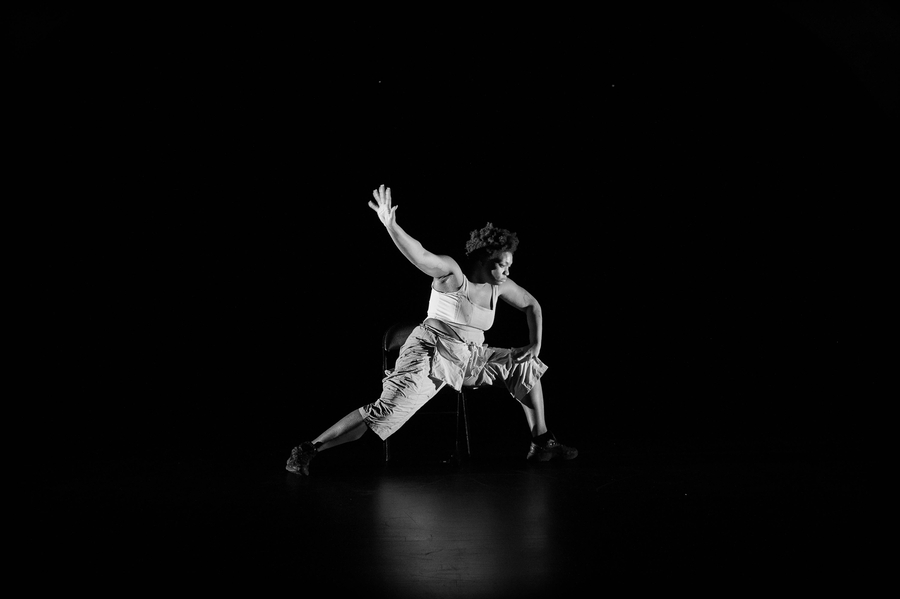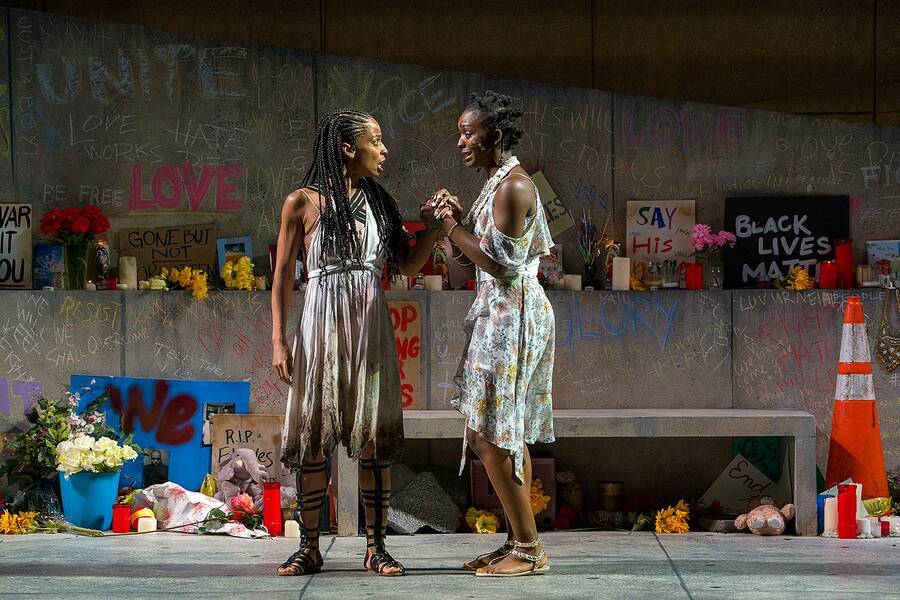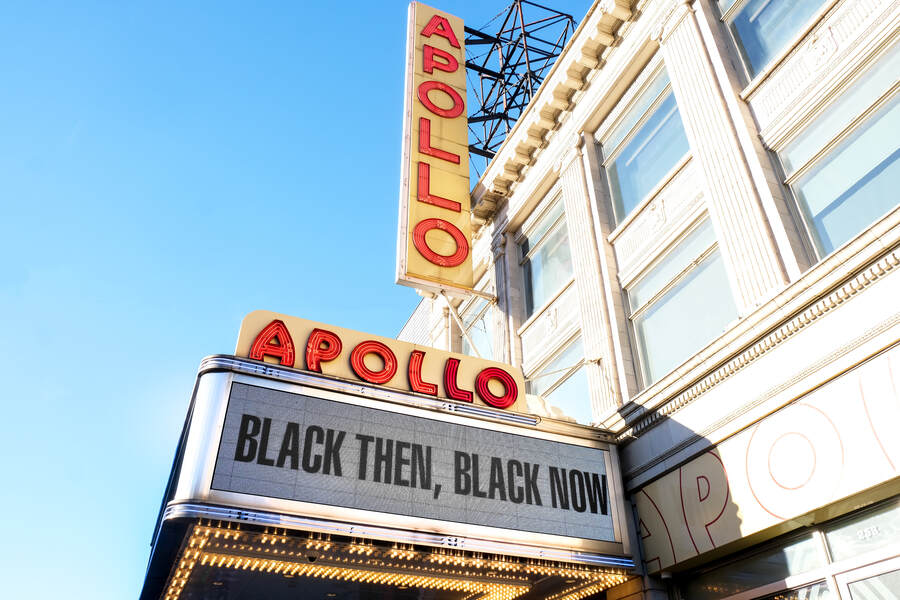If all the world’s a stage, then Harlem has a leading role. The history-rich neighborhood has been a beacon of Black talent for well over a century and still harbors a plethora of world-class cultural institutions. Many of these institutions—be they privately owned companies, nonprofits, or theatre collectives—call Harlem home because of its indelible legacy of art-making and social justice, as well as the vibrant community of locals and transplants. The present-day challenges faced by these institutions run the gamut depending on their size, operating budget, programming restrictions, and, most of all, access to capital. Fortunately, with the current group of artistic directors and executive producers rooted throughout the 45 or so blocks in Uptown Manhattan and committed to making theatre live there, hardship may have met its match.
Even with a general climate of crisis in the theatre industry at large, Harlem organizations are expanding in both literal and metaphorical ways: embarking on ambitious renovations, celebrating landmark seasons, and uprooting traditional modes of storytelling. To gauge just how theatres in this historic neighborhood are navigating through the post-COVID lockdown obstacles of theatremaking (the nationwide rollback of arts funding, hesitant audience members, the blistering of NYC’s arts labor sector, etc.), American Theatre sat down with key players at a variety of Black and POC-led organizations to discuss the true state of theatre in Harlem.
I began by looking at the major venues with decades of programming under their belt. Take the Apollo Theater, for instance, currently in the midst of the first full-scale renovation of its landmarked Historic Theater, in addition to breaking ground on two new flexible spaces at the Victoria Theater slated to open in spring 2024.
When I asked executive producer Kamilah Forbes if she can see the finish line for a process this taxing (the Apollo Rising 2.0 capital campaign has set its goal at $80 million dollars), she was encouragingly hopeful.
“Yes, there is a finish line in our sights, but as a 90-year-old institution, we’ve lived many lives,” Forbes said. “History knows us as a music venue. But for the last 15 years, we’ve expanded to include multiple disciplines, and, in preparation for the opening of the Victoria, we’ve commissioned a slew of different kinds of artists and made major investments in new-work development.”
The mission to open up Apollo’s doors even wider is personal for Forbes, an awarded film and theatre director, producer, and artist. She knows firsthand that spaces for Black artists to build worlds, excavate their imaginations, and even fail a few times before trying again, are very limited.

One such space, however, has always been the National Black Theatre (NBT). NBT was founded in 1968 by the ultimate champion of Black artistic liberation, Dr. Barbara Ann Teer, and became the first revenue generating Black arts complex in the nation. NBT—now under the tenure of Teer’s daughter Sade Lythcott as CEO and Jonathan McCrory as executive artistic director—has never simply been a theatre. For many, it’s more like a home. And after three years of unprecedented hardships for many commercial producers, the home team celebrated a major first: a Broadway production.
NBT co-produced James Ijames’ Pulitzer-winning comedy Fat Ham, which closed earlier this summer after an extended run at the American Airlines Theatre (this season they’re a co-producer of the current Broadway revival of Purlie Victorious). But the celebratory kiki in honor of that accomplishment had to take place in another building, as NBT is also undergoing major reconstruction. According to reports, the National Black Theatre redevelopment project is slated to include a 21-story building and serve as the permanent home for the NBT. It will also include space that centers the community through intentional collision spaces, activated retail, a large-scale events venue, and new residential units.
The endgame for this development looks a bit further away than the Apollo’s plans. Currently, it is slated for 2026. The venture required NBT to undergo the Uniform Land Use Review Procedure (ULURP), which involved years of public hearings, forging relationships with city politicians, and building up a deep familiarity with New York City zoning laws.
“Our unofficial organizational mascot has always been a turtle,” Lythcott said with a warming smile. “You don’t get to be a Black institution that’s 55 years old and now doing some of the most catalytic work we’ve ever done in the history of our organization without taking the approach of the marathon.”
That’s because the capitalist race to make the biggest, baddest theatre does not always meet the community’s needs. “We spend no time looking to the left or right,” Lythcott said. “We’re entirely committed to our mission and vision throughout this project. Sure, our black box will be upgraded to a Studio Theater, but it’s still just 99 seats. The Temple of Liberation will still be a flex space, but now we can do immersive, extended-reality technology. We want to be the same organization the community has come to love and depend on, but with deeper resources. Our people deserve that. And for us, success always goes back to the artists, the community members, and the ability to tell these authentic stories.”
Lythcott called this mentality “brand true, not brand new”—a phrase that has become like a mission statement within the organization, as McCrory repeated it back to me in a separate interview.
It’s a sentiment that mirrors one touted by NBT’s neighbor a mile and a half away, Harlem Stage. In promotions of Harlem Stage’s 40th anniversary season, CEO and artistic director Patricia Cruz encourages the act of “looking back and creating forward.” Cruz has done her fair share of both. Originally an actor from Chicago, she was lured by Coltrane’s saxophone and Coleman’s horn to move to New York City, where she met her husband, the late artist Emilio Cruz. The pair went on to champion Black creators over the course of their careers, with Cruz joining Harlem Stage as executive director in 1998, when it was still called Aaron Davis Hall.
In that spirit of looking back and creating forward for the 40th anniversary, Cruz and her team invited back artists with longstanding relationships to the organization to curate the flagship season. They placed two of the company’s signature programs, WaterWorks and E-Moves, in the hands of prolific creators like Camille A. Brown, Bill T. Jones, and Kyle Abraham, all of whom were granted the freedom to commission younger artists they’ve collaborated with over the years—associate choreographers, members of their independent companies, etc. As Cruz tells it, “Harlem Stage has become known as a place where artists really are shaping what they want to put forward to the world. We believe in their visions.”

Harlem Stage has its own venue where this work has been and will continue to be performed—the Gatehouse located on 135th and Convent Avenue—and is two years into a five-year campaign to raise $25 million dollars to sustain the company’s artist-of-color-led programming. They’re already at $14 million, Cruz said.
“We’ve got a team of people who believe in this work,” she said. “And they help us to identify funders who believe in what we’re doing. We have grown from the institution that, like many in our community, was frankly on the brink of financial catastrophe because it was more expensive than we could afford. We just kept at it. It’s all about knowing you will learn a lot from the hard times, and you’ll be able to greet the good times with joy and a smile on your face.”
Harlem Stage’s joy-fueled approach seems to be working. And reinvestment in local talent is needed now more than ever as live theatre—particularly in white-run venues in the rest of the city and nationwide—struggles to find its previously tourist-driven footing, and long-time NYC businesses and residents face displacement due to the escalation of property taxes and rents. It can be easier, though, to break through fundraising barriers when you operate out of a brick-and-mortar space, as Harlem Stage has for decades.
Few know this better than the leaders at New Heritage Theatre Project, which for many years did have its own presenting venue on 125th Street but lost it in a changing of the real estate guards. The loss of space presented new challenges, but also new opportunities for partnership. As executive artistic producer Jamal Joseph put it, “Theatre is where the people are.”
New Heritage was founded in 1964 by the late actor, playwright, and director Roger Furman, a member of the reputable American Negro Theater (ANT), with the mission to sustain and preserve classic Black works. New Heritage was to be a safe haven for artists at a time of extreme political strife. Joseph is a walking testament to Furman’s success, as the former joined the latter at New Heritage in 1988—the same year he was released from USP Leavenworth federal prison.
Joseph had served time there because of his affiliation with the Black Panther Party and other liberation movements; he was one of the defendants in the Panther 21 trial in 1971, and was later convicted of harboring a fugitive in another case. It was during his time at Leavenworth that the seeds—originally planted in him by none other than Dr. Teer’s National Black Theatre—began to bloom, and he wrote a play that made its way onto New Heritage’s desk. When it was time for his next project to bear fruit into a full-scale production, it was again NBT that stepped up to the plate as a collaborator.
Generative relationships like these have helped to sustain New Heritage over the decades. And they don’t always blossom in a traditional theatre space. One of New Heritage’s most recent productions, Love Warrior, set its sights on even more hallowed ground: a church. First Corinthian Baptist Church in central Harlem, to be specific, under the leadership of Senior Pastor Michael A. Walrond Jr. and the Associate Pastor of Arts and Spiritual Formation, Desiree Elder.
“Pastor Mike envisioned the church as an art space; it’s been renovated so that it’s a stage, not a traditional pulpit,” said Joseph. “It is a place of celebration on a Sunday morning, but it is also a place that has become a presenting venue known as The Sanctuary, where New Heritage has presented several different works.” In this way, the company offers another kind of worship: the expression of reverence for theatrical creativity and catharsis.
Joseph knows that flexibility—a skill that has always been inherent in Black artists—may need to become the new blueprint for the greater landscape of American theatre.
“As the shift has happened nationally in terms of what and who the arts represent, we also see conservative administrations start to devalue the field,” Joseph said. “It’s not lost on me that we’re talking about this on the day when the Supreme Court struck down affirmative action. What does that mean for those young dreamers? I’d love to see funders come in and say, ‘Here’s money to create a brick-and-mortar institution that is funded in perpetuity,’ but the other part of this is to understand and always credit the people we’ve already touched by going into the community—performing at block parties, churches, and rallies.”
The Classical Theatre of Harlem (CTH) would add parks to that list. Since 2013, it has presented Uptown Shakespeare in the Park, world-class productions of classics staged in Marcus Garvey Park. Both of its most recent works—Shakespeare’s hilarious and heartbreaking Twelfth Night, and playwright Betty Shamieh’s comedic sequel to it, Malvolio—were New York Times critic’s picks. Best of all: Every one of CTH’s works are priced at little to no cost, which gives it one of the most racially, generationally, and socioeconomically diverse theatre audiences in New York City.

Beyond the park, plans are underway to build the Harlem Classical Arts Complex, a venue that would host not only CTH but the Harlem Chamber Players and the Harlem Opera Theater. Plans for the complex are still in their infancy, but producing artistic director Ty Jones said that the strategy behind its placement has been years in the making.
“The space would be on 141st and St. Nicholas,” he said. “On that block there are two schools, a parking garage, Harlem School of the Arts, and St. James Church. Foot traffic from all of those spaces will go right up to Amsterdam Avenue, where there is a burgeoning small business community. We would see a model block that marries education and arts and commerce for the betterment of a community.”
The complex is more than just a vanity project for Jones, who recognizes the value of a home base for an arts nonprofit. Jones first stepped into his current role in 2009, shortly after the financial crash and issues with the company leadership had pushed CTH to the brink of collapse. Jones, who had experience running his own painting business in college, rolled up his sleeves, slashed his own paycheck, and put his small business skills to work on a much larger scale to keep the organization alive.
While Jones ambitiously envisions an arts movement that would echo the Harlem Renaissance of the early 20th century, he has a more immediate wish for his company.
“I’m hoping we can convince those in government to grant us permanence at Marcus Garvey Park,” he said, rather than having to go through the permitting process each summer, as they have done for years. “I believe we’ve demonstrated that we are not monopolizing the space. Other cultural institutions can still perform there before we go on. We’ve actually done that with at least eight other institutions throughout the month. That’s even more than months at the park when we’re not there.”
Not every influential theatre with roots in Harlem has a permanent residence there. Among the organizations that have undoubtedly helped to shape the landscape of Black theatre in the 21st century, but without a consistent home base, is The Movement Theatre Company. As their name might suggest, home is everywhere they go.
The Movement Theatre Company was founded by 15 NYU theatre school graduates seeking a forum to share authentic and complex stories about their cultures and important issues impacting the world. Summer 2023 marks 16 years of The Movement’s richly diverse, often social justice-oriented programming, all done without a building. As Deadria Harrington, Eric Lockley, and David Mendizábal—three of the company’s four producing artistic leaders—remind me, it’s possible to carry the spirit of Harlem in any room. That spirit, Mendizábal explained, goes beyond any four walls.
“With us, there is a different energy around hospitality and welcoming—a sense of invitation that I have not always felt as an audience or even as an invited artist in some of these white institutions,” said Mendizábal. “There, I have been invited, and I arrive, but I still feel like no one knows I’m supposed to be there. So for us, it’s important to create a sense of belonging.”
The Movement has already taken this inclusive energy into the halls of New Georges (The Cotillion, 2023), Playwrights Horizons (What to Send Up When It Goes Down, 2021), La MaMa E.T.C. (Hope Speaks, 2011-2012). But The Movement’s Harlem Nights program—a series of non-traditional theatrical events in partnership with local Harlem businesses that ran from 2011 through 2017—is the one the trio speaks about most affectionately.
“Our capacity to put up mainstage productions and maintain the Harlem Nights programming simultaneously became challenging after [2017], and then the pandemic doubly challenged things…We’re working with a development consultant and strategic planner, and are saying big things like, ‘The Movement needs to be a $750,000 organization in the next three to five years,’” said Harrington. “But really, it’s about how we can grow to have programming like Harlem Nights happen every year. So no matter where we are, we can have work that directly pours into Harlem the way the neighborhood has always poured into us.”
In conversation after conversation with Black and brown leaders in the industry, this urge to reinvest keeps coming up. It’s a compulsion of gratitude, of course, but also a way to prolong and build on the work they have all sacrificed so much for. How, then, can we—audience members, fellow practitioners, arts patrons—support their lionhearted efforts? By treating the success of Black institutions as more than just a want but an undeniable need. We need to ensure the livelihoods of these uptown organizations. As Sandra A. Daley-Sharif—who, alongside five other producing partners, organizes Harlem9’s annual “48 Hours in…™Harlem” event, last held on Aug. 27—states plainly, art has to go into your allowance.
“The hard fact is, if you love these Black organizations, $20 or $25 a month has to be in your budget; that’s the real of it,” Daley-Sharif said. “There are a lot of big funders like NYSCA (New York State Council on the Arts) coming out of COVID who are going to change guidelines and eligibility requirements. So us, The Fire This Time Festival, Liberation Theatre Company—the only way any of us are going to actually survive is if we get paid. How many Black theatres are true companies? We’re doing this outside of full-time jobs and parenting; we don’t have salaried folks with health insurance and all those things.
“I was talking to a friend who does development work, and you know what he said to me? He said the NYSCAs are always gonna come and go; the real heart of your support is those individual people that love you. Are you nurturing them? I like to think we’re nurturing them. But I also want to ask, are they nurturing us?”
Brittani Samuel (she/her) is a New York-based writer, critic, and co-editor of 3Views on Theater. Words can be found at Elle, Observer, The New York Times, and more. She can be found at BrittaniSamuel.com or on Instagram at @brittaniidiannee.





